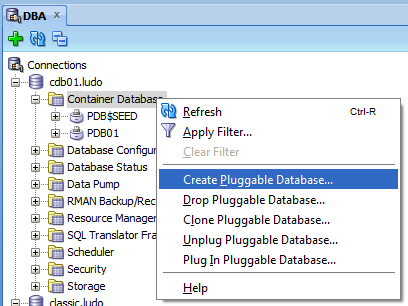I’m creating a new 12c RAC environment from scratch, Ii just want to track a few notes (primarily for my personal use ;-)) about the _PSU.
The opatch utility bundled with the GI does not contain the emocmrsp, so it is necessary to install the latest opatch (6880880).
The patching process can patch both GI and RAC homes at once, but if you don’t have a valid database registered, an error is raised:
|
1 2 3 4 5 |
# opatchauto apply /root/psu/17735306 -ocmrf /home/oracle/ocm.rsp [...] System Configuration Collection failed: oracle.osysmodel.driver.crs.productdriver.ProductDriverException: PRCD-1061 : No database exists opatchauto failed with error code 2. |
So you need to patch the Oracle Homes individually if it’s a new installation.
Remind that:
- The patch must be unzipped by the oracle/grid user in a directory readable to oracle and root (or it will fail with Argument(s) Error… Patch Location not valid) or other funny errors (permission denied errors in the middle of the patch process)
- Must be applied by the root user
- Must be applied individually and on every node, one node at time.
- The opatchauto executable must belong to one of the OH you’re patching (so if you patch GI and RAC separately, you have to use the correspondent opatch.
Grid:
|
1 2 3 4 5 6 7 8 9 10 11 12 13 14 15 16 17 18 19 20 21 22 23 24 25 26 27 28 29 30 31 32 33 34 35 36 37 |
[root@rac1 psu]# opatchauto apply /tmp/psu/17735306 -oh /u01/app/12.1.0/grid -ocmrf /home/oracle/ocm.rsp OPatch Automation Tool Copyright (c) 2013, Oracle Corporation. All rights reserved. OPatchauto version : 12.1.0.1.2 OUI version : 12.1.0.1.0 Running from : /u01/app/12.1.0/grid opatchauto log file: /u01/app/12.1.0/grid/cfgtoollogs/opatchauto/17735306/opatch_gi_2014-02-13_17-49-19_deploy.log Parameter Validation: Successful User specified following Grid Infrastructure home: /u01/app/12.1.0/grid Configuration Validation: Successful Patch Location: /tmp/psu/17735306 Grid Infrastructure Patch(es): 17077442 17303297 17552800 RAC Patch(es): 17077442 17552800 Patch Validation: Successful Stopping CRS ... Successful Applying patch(es) to "/u01/app/12.1.0/grid" ... Patch "/tmp/psu/17735306/17077442" successfully applied to "/u01/app/12.1.0/grid". Patch "/tmp/psu/17735306/17303297" successfully applied to "/u01/app/12.1.0/grid". Patch "/tmp/psu/17735306/17552800" successfully applied to "/u01/app/12.1.0/grid". Starting CRS ... Successful Apply Summary: Following patch(es) are successfully installed: GI Home: /u01/app/12.1.0/grid: 17077442, 17303297, 17552800 opatchauto succeeded. |
RAC:
|
1 2 3 4 5 6 7 8 9 10 11 12 13 14 15 16 17 18 19 20 21 22 23 24 25 26 27 28 29 30 31 32 33 34 35 36 37 38 39 |
[root@rac1 psu]# export PATH=/u01/app/oracle/product/12.1.0/dbhome_1/OPatch/:/usr/lib64/qt-3.3/bin:/usr/local/sbin:/usr/local/bin:/sbin:/bin:/usr/sbin:/usr/bin:/root/bin [root@rac1 psu]# opatchauto apply /tmp/psu/17735306 -oh /u01/app/oracle/product/12.1.0/dbhome_1/ -ocmrf /home/oracle/ocm.rsp OPatch Automation Tool Copyright (c) 2013, Oracle Corporation. All rights reserved. OPatchauto version : 12.1.0.1.2 OUI version : 12.1.0.1.0 Running from : /u01/app/oracle/product/12.1.0/dbhome_1 opatchauto log file: /u01/app/12.1.0/grid/cfgtoollogs/opatchauto/17735306/opatch_gi_2014-02-13_18-12-10_deploy.log Parameter Validation: Successful User specified the following RAC home(s) for this session: /u01/app/oracle/product/12.1.0/dbhome_1 Configuration Validation: Successful Patch Location: /tmp/psu/17735306 Grid Infrastructure Patch(es): 17077442 17303297 17552800 RAC Patch(es): 17077442 17552800 Patch Validation: Successful Stopping RAC (/u01/app/oracle/product/12.1.0/dbhome_1) ... Successful Applying patch(es) to "/u01/app/oracle/product/12.1.0/dbhome_1" ... Patch "/tmp/psu/17735306/17077442" successfully applied to "/u01/app/oracle/product/12.1.0/dbhome_1". Patch "/tmp/psu/17735306/17552800" successfully applied to "/u01/app/oracle/product/12.1.0/dbhome_1". Starting RAC (/u01/app/oracle/product/12.1.0/dbhome_1) ... Successful [WARNING] The local database(s) on "/u01/app/oracle/product/12.1.0/dbhome_1" is not running. SQL changes, if any, cannot be applied. Apply Summary: Following patch(es) are successfully installed: RAC Home: /u01/app/oracle/product/12.1.0/dbhome_1: 17077442, 17552800 opatchauto succeeded. |
Cheers
—
Ludovico






